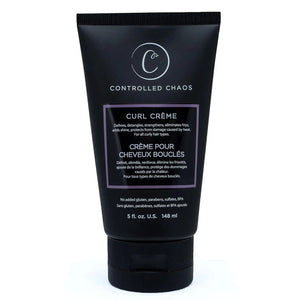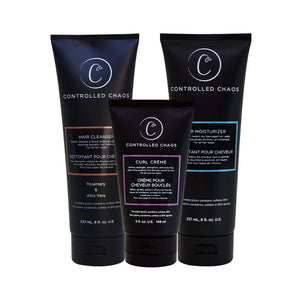

Curly hair is a beautiful blessing, but it comes with its challenges, one of which is breakage. Whether it's due to excessive manipulation, or lack of moisture, breakage can be frustrating for those with curly hair. However, with the proper care and attention, you can minimize breakage and keep your curls healthy and vibrant. This blog will discuss some effective strategies for preventing curly hair breakage.
Understanding Curly Hair:
Curly hair is typically drier than straight hair because the natural oils produced by the scalp have more difficulty getting down the spiral-shaped strands. In addition, because of its structure and texture, curly hair is more likely to split and tangle.Therefore, it requires specific care to maintain its health and integrity.
Tips for Preventing Curly Hair Breakage:
Gentle Cleansing:
Start your curly hair care regimen with a co-wash or mild cleansing shampoo. Look for sulfate-free formulas that won't strip your hair of natural oils. Too frequently cleansing can lead to dryness and breakage, so wash your hair at most twice to thrice a week.
Hydration is Key:
Curly hair thrives on moisture, so hydrate your locks regularly. After every wash, use a thick, nourishing conditioner to help your curls regain moisture and vigor. To give your hair an extra dose of hydration, consider adding deep conditioning treatments to your routine. These treatments are great for protecting curls from breakage.
Detangle with Care:
Tangling is standard in curly hair, especially in moist conditions. To avoid breaking knots, gently work through them from the bottom up with your fingers or a wide-tooth comb. Use a detangling spray or leave-in conditioner to help untangle and expedite the process.
Minimize Heat Styling:
Excessive heat styling can weaken curly hair and lead to breakage over time. Opt for heat-free styling methods such as air-drying, diffusing, or using flexi-rods or rollers to create curls whenever possible. If you use heat tools, apply a heat protectant spray beforehand and use the lowest heat setting possible.
Protective Styling:
Protective hairstyles can help minimize breakage by keeping your curls tucked away and shielded from environmental damage. Consider styles like braids, twists, buns, or updos that don't put too much stress on your hair. Just be sure not to make protective styles too tight, as this can cause tension and breakage at the hairline.
Trim Regularly:
Frequent cuts are necessary to keep curls healthy and stop split ends, which, if ignored, can cause breakage. Try getting a haircut every 8–12 weeks to keep your hair looking alive and healthy by removing broken or damaged ends.
Protective Products:
In addition to a good conditioner, incorporate products specifically designed to prevent curly hair breakage on top of the head. Look for leave-in treatments, serums, or oils enriched with keratin, coconut oil, or shea butter to fortify your strands and minimize breakage.
Stay Hydrated and Eat a Balanced Diet:
Since healthy hair grows from the inside out, care for your body by drinking lots of water and eating a balanced diet. Foods like salmon, avocado, nuts, and leafy greens can promote hair health and strengthen your strands from the inside out. Additionally, consider taking a biotin supplement or a hair-specific multivitamin to support your hair's growth and strength.
Be Patient and Gentle:
Lastly, be patient with your hair and give it the love and care it deserves. Avoid harsh handling, excessive brushing, or tight hairstyles that cause stress and breakage. With time, consistency, and gentle care, you can achieve healthy, resilient curls that make you feel confident and beautiful.
Nighttime Care Routine:
Implementing a nighttime care routine can help protect your curls while you sleep. You can also pineapple your curls by loosely gathering them at the top of your head and securing them with a satin scrunchie or hair tie. This keeps your curls intact and prevents them from flattening or crushed overnight.
Regular Scalp Massages:
Scalp health is essential for maintaining strong, resilient curls. Incorporating regular scalp massages into your hair care routine can stimulate blood flow, focusing on areas where you may experience dryness or tension. You can also use a lightweight scalp oil or serum to nourish and hydrate your scalp while massaging.
Avoiding Over-Manipulation:
Over-manipulation can put undue stress on your curls and lead to breakage. Avoid constantly touching, pulling, or twirling your hair throughout the day, as this can weaken the hair shaft and cause damage. Instead, embrace a hands-off approach and allow your curls to breathe and move freely. Minimize using hair accessories like elastic bands or clips that can snag and pull on your hair, opting for gentle alternatives like hair sticks or silk scrunchies.
Consultation with a Professional Stylist:
If you're struggling with persistent breakage despite your best efforts, consider scheduling a consultation with a professional stylist specializing in curly hair. A professional trim or restructuring treatment may be necessary to address damage and restore the health of your curls.
Conclusion:
Avoiding curly hair breakage is a journey that calls for tolerance, regularity, and an openness to hearing your hair needs. You can keep your curls strong, healthy, and beautiful by implementing a holistic approach to hair care, including proper hydration, gentle handling, protective styling, and regular maintenance. Remember that every curl is unique, so don't be afraid to experiment with different techniques and products to find what works best for you.
Faqs
How to fix breakage on curly hair?
To fix breakage in curly hair, trim split ends and focus on deep conditioning treatments to strengthen and nourish the hair. Additionally, minimize heat styling and avoid harsh chemical treatments that can further damage the hair.
Is breakage normal for curly hair?
Due to curly hair's fragile nature, breakage can be expected. However, excessive breakage may indicate underlying issues such as dryness, over-manipulation, or lack of proper care. Addressing these factors with a tailored hair care routine can help minimize breakage and promote healthy curls.
How do you fix curly damaged hair?
Repairing damaged curly hair involves a combination of hydration, protein treatments, and gentle handling. Use moisturizing shampoos and conditioners, regularly incorporate deep conditioning masks, and limit heat styling to allow your curls to recover and regain strength.
What does curly hair breakage look like?
Curly hair breakage can manifest as split ends, thinning strands, or excessive shedding. You may notice shorter pieces of hair scattered throughout your curls or a need for more elasticity when stretched. Effective prevention and management of breakage can be achieved with regular trims and good hair care.
Can environmental factors contribute to breakage in curly hair?
Yes, environmental factors such as sun exposure, humidity, and pollution can contribute to breakage in curly hair. Protect your curls by wearing hats or scarves outdoors, using anti-frizz products, and incorporating clarifying shampoos to remove buildup caused by environmental pollutants.
How can I minimize breakage while detangling my curly hair?
Minimize breakage while detangling curly hair by gently working through knots from the bottom up with a wide-tooth comb or your fingers. Detangling can be made easier and less damaging using a leave-in conditioner or detangling spray to moisturize the strands and lessen friction.




















